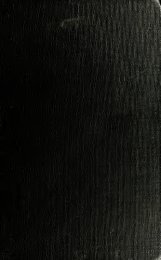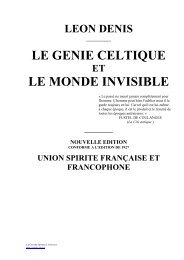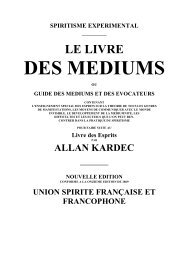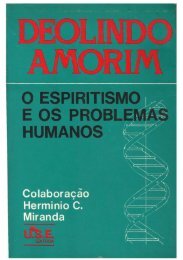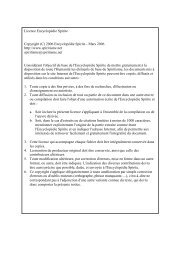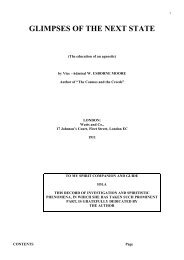Experimental investigation of the spirit manifestations, [electronic ...
Experimental investigation of the spirit manifestations, [electronic ...
Experimental investigation of the spirit manifestations, [electronic ...
- No tags were found...
Create successful ePaper yourself
Turn your PDF publications into a flip-book with our unique Google optimized e-Paper software.
APPENDIX. 457<strong>the</strong> coils <strong>of</strong> an clcctro-magnct, secondary waves arc induced, called secondarycurrents. It seems reasonable to ascribe tlicsi; waves to <strong>the</strong> sameshifting <strong>of</strong> <strong>the</strong> poles, which produces <strong>the</strong> sunorilie undulations.'^-80. Within <strong>the</strong> bodies <strong>of</strong> animals and vegetables, <strong>the</strong> electro-e<strong>the</strong>r maybe supposed to exist as an atmosphere surrounding tlie etlicrco-poMdcrableatoms <strong>of</strong> which <strong>the</strong>ir organs are constituted, so as to occupy all <strong>the</strong> spacewhich is not replete with such atoms. Hence a discharge <strong>of</strong> frictionalelectricity may indirectly polarize <strong>the</strong> whole animal frame, by producingcthcreo-ponderable polarization in <strong>the</strong> constituent atoms <strong>of</strong> <strong>the</strong> fibres <strong>of</strong>* Thcso phenomena excite more interest in consequence <strong>of</strong> <strong>the</strong> employment, for medicalpurposes, <strong>of</strong> an apparatus originally contrived by Callau, but since ingeniously modifiedl)y our countryman, Dr. Page, into a form which has been designated as <strong>the</strong> electrotorae.A coil <strong>of</strong> coarse copper wire, covered with cotton, like bonnet Avire, is wound about awooden cylinder. Around <strong>the</strong> coil thus formed, a coil <strong>of</strong> fine copper wire similarly coveredis wound, leaving <strong>the</strong> extremities accessible. One end <strong>of</strong> <strong>the</strong> coarse coil communicatingconstantly with one pole <strong>of</strong> a galvanic battery, <strong>the</strong> o<strong>the</strong>r end is left free ; so that by scrapingwith it <strong>the</strong> teeth <strong>of</strong> a rasp attached to <strong>the</strong> o<strong>the</strong>r pole, a rapid closing and opening <strong>of</strong><strong>the</strong> circuit may be effected. Under <strong>the</strong>se circumstances, an observer, holding <strong>the</strong> ends <strong>of</strong><strong>the</strong> fine coil, receivesshocks more or less severe, according to <strong>the</strong> construction <strong>of</strong> <strong>the</strong> battery,<strong>the</strong> energy <strong>of</strong> <strong>the</strong> agents employed to excite it, or <strong>the</strong> total weight and relative dimensions<strong>of</strong> <strong>the</strong> coils as to length and sectional area. Agreeably to <strong>the</strong> received doctrine,<strong>the</strong> shocks thus produced arc owing to secondary currents caused by dynamic induction.Agreeably to <strong>the</strong> hypo<strong>the</strong>sis which I have advanced, <strong>the</strong> atoms <strong>of</strong> <strong>the</strong> coarse wire, polarizedby waves proceeding from <strong>the</strong> poles <strong>of</strong> <strong>the</strong> batter}', induce a corresponding polarization<strong>of</strong> <strong>the</strong> atoms <strong>of</strong> <strong>the</strong> fine wire; <strong>the</strong> aggregate polarity imparted being as <strong>the</strong> number<strong>of</strong> atoms in <strong>the</strong> former to <strong>the</strong> number <strong>of</strong> atoms in <strong>the</strong> latter: or (to use an equivalentratio) as <strong>the</strong> weight <strong>of</strong> <strong>the</strong> coarse, to <strong>the</strong> weight <strong>of</strong> <strong>the</strong> fine wire. But as on breaking <strong>the</strong>circuit through <strong>the</strong> coarse wire, <strong>the</strong> e<strong>the</strong>reo-ponderable atoms in both wires resume <strong>the</strong>irneutral positions, while this requires each circuit to be run through within <strong>the</strong> same minuteinterval, <strong>the</strong> velocities <strong>of</strong> <strong>the</strong>ir respective waves will be inversely as <strong>the</strong>ir sectional areasand directly as <strong>the</strong>ir lengths : in o<strong>the</strong>r words, <strong>the</strong> velocit}'' in <strong>the</strong> fine wire will be as muchgreater as <strong>the</strong> channel which it affords is narrower and longer. The cylinder includedwithin <strong>the</strong> coils as above stated being removed, a cylindrical space is vacated. If into<strong>the</strong> cavity thus made iron rods, like knitting needles, be introduced, one after <strong>the</strong> o<strong>the</strong>r,while <strong>the</strong> apparatus is in operation, <strong>the</strong> shocks increase in severity as <strong>the</strong> number augments;so that from being supportable <strong>the</strong>y may be rendered intolerable. The shocktakes place without <strong>the</strong> presence <strong>of</strong> iron, but is much increased by its assistance.---These facts appear to me to justify a surmise that <strong>the</strong> e<strong>the</strong>reo-ponderable atoms <strong>of</strong> iron,in becoming magnetized and demagnetized, co-operate with <strong>the</strong> e<strong>the</strong>reo-ponderable atoms<strong>of</strong> <strong>the</strong> copper coils in <strong>the</strong> induction <strong>of</strong> secondai'y undulations. It is conceived that <strong>the</strong>semay be owing to <strong>the</strong> intestinal change attended by sound, as above stated, (73;) thisbeing caused by a sudden approximation <strong>of</strong> <strong>the</strong> poles <strong>of</strong> <strong>the</strong> atoms, previously movedapart by <strong>the</strong> influence <strong>of</strong> <strong>the</strong> galvanized coil. But if this sudden coming toge<strong>the</strong>r <strong>of</strong> <strong>the</strong>previously separated poles <strong>of</strong> atoms within a magnetized cyilndcr <strong>of</strong> iron, can contributeto <strong>the</strong> energy <strong>of</strong> secondary waves, it is consistent to infer that <strong>the</strong>se waves owe <strong>the</strong>ir originto an analogous approximation <strong>of</strong> <strong>the</strong> separated poles <strong>of</strong> <strong>the</strong> cupreous atoms, forming th<strong>of</strong>iner coil, in which <strong>the</strong> secondary undulations may be created without <strong>the</strong> presence <strong>of</strong>iron. Of course, this reasoning will apply to all cases in which <strong>the</strong> phenomena hi<strong>the</strong>rtoattributed to Farradian currents are <strong>the</strong> result <strong>of</strong> dynamic induction.Thus it appears that <strong>the</strong> polarization <strong>of</strong> magnets, and that created and sustained whena galvanized coil or helix acts upon ano<strong>the</strong>r in proximit}', have <strong>the</strong> same relation to galvanicdischarges that <strong>the</strong> charges upon insulated surfaces have to <strong>the</strong>ir appropriate discharges.The permanent magnetism <strong>of</strong> steel seems to have some analogy with <strong>the</strong> chargeupon a coated jiane, while we may consider as analogous with <strong>the</strong> charges upon insulatedconductors, already adverted to, (61, 62,) that state <strong>of</strong> <strong>the</strong> e<strong>the</strong>reo-ponderable particles,(38,) <strong>of</strong> a wire helix, which state, resulting from <strong>the</strong> influence <strong>of</strong> an included magnet, orneighbouring galvanized coil, and being discharged on a change <strong>of</strong> relative position, orbreach <strong>of</strong> <strong>the</strong> galvanizing circuit, is productive <strong>of</strong> spark, shock, ignition, or electrolysis,as exemplified by Callan's coil. Page's electrotome, or <strong>the</strong> magneto-electric machine.^' Agreeably to <strong>the</strong> usual construction, tho cylinder about which tho inner coarse wirecoil is wound is originally <strong>of</strong> iron, so that <strong>the</strong>re is as much <strong>of</strong> this metal contained as itcan hold. Various contrivances are resorted to fur <strong>the</strong> closing and opening <strong>of</strong> <strong>the</strong> circuit,which arc more ingenious and convenient than scraping a rasp, as above described.



